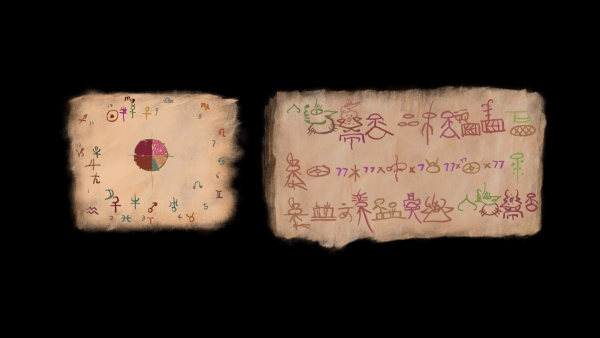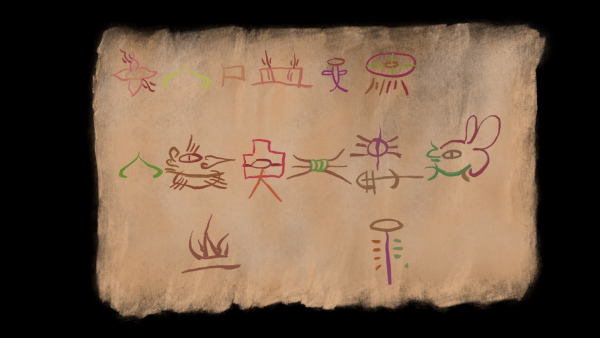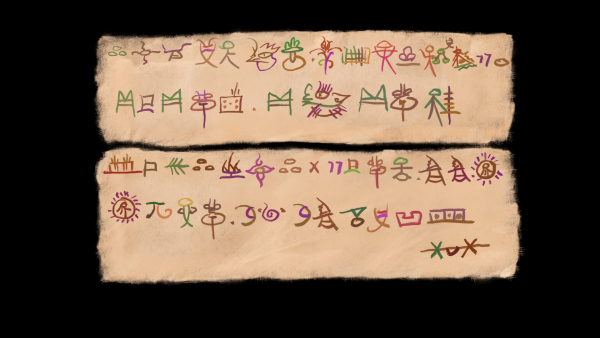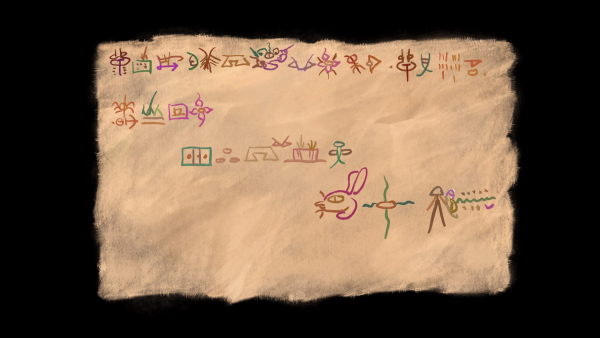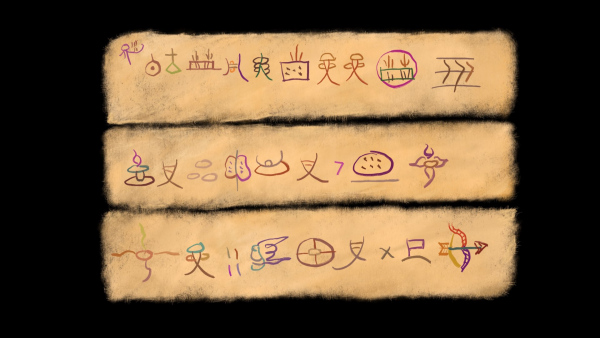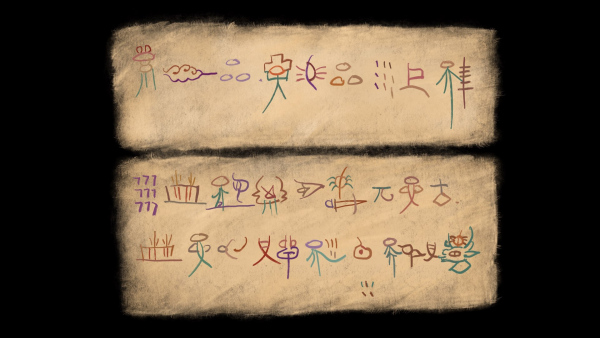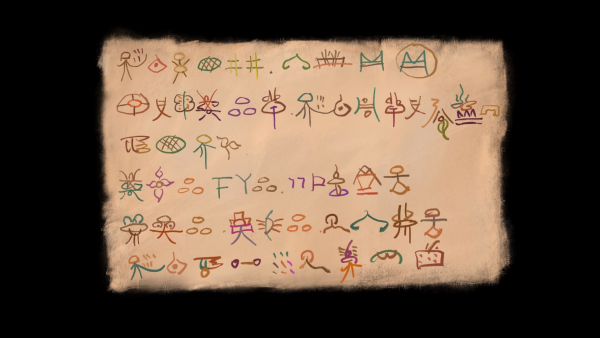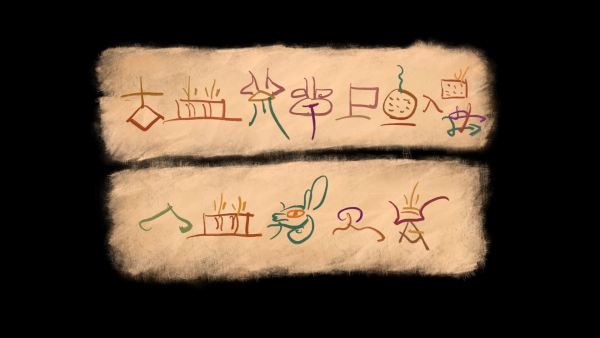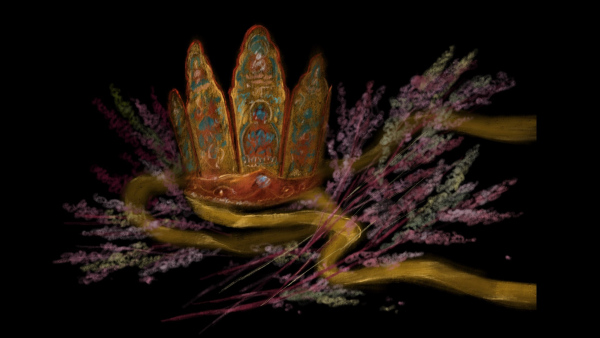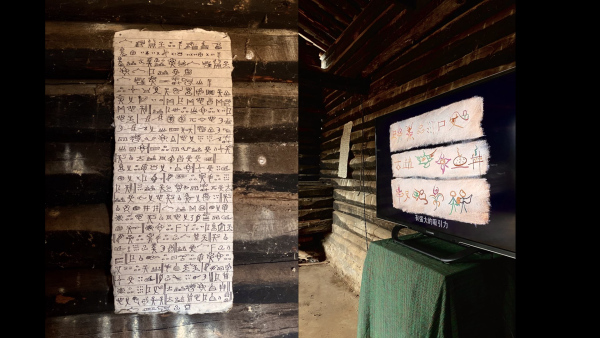Astrology For The Quinoa land art Festival
Tianzi Wild Kitchen · Astrological Inscriptions
This projet was created by the artist Galaxia Wang for the "Quinoa land Art Festival" residency in Tai'an, Lijiang, Yunnan in 2020.
During the quinoa harvest season, the artist Galaxia Wang came to Tianzi Wild Kitchen to perform astrology divination. The exhibition is in the form of a video installation. The creation of this work is to bless the harvest of quinoa and the art festival. Based on the space-time coordinates of Tianzi Wild Kitchen, the author interprets the astrological fate of the quinoa harvest as a person's birth, sees the past and present changes of this land in the astrology, and makes expectations for the future. The author cooperates with the local Dongba priests to translate the inscriptions into Dongba language, and transcribe them according to the five colors of quinoa. Combining the native belief and spirituality of the land, we sincerely call on people to respect the earth, protect the pure and sustainable ecology, and return to the nourishment of the body, mind and soul of the heaven and earth.
The following is a collaborative discussion between the artist and Dongba Priest He Jun (W is Galaxia Wang, H is Dongba Priest He Jun)
W: I heard from Jiawu(another young Dongba Priest He Jiawu) that you participated in the proofreading of the Dongba translation of our inscriptions. At the beginning, there was a choice between transliteration and free translation, right?
H: For the translation, it is just like the word “Jianghu” (river and lake, blood brothers) in our Chinese language. It cannot be translated, and it lacks the artistic conception of the original text or inscription poems. It turns out that we have been deliberating for a long time, and I can't reach what you want at once. So then I translated a vernacular version.
W: It is still based on the content of our divination, so we chose free translation afterwards.
W: For the inheritance and development of Dongba language, do we have any normative requirements when inheriting it? Like what is the difference between written Dongba language and oral language?
H: You are talking about Dongba language...any difference in pronunciation?
The difference between ancient Naxi minority language and modern Dongba language is similar to the difference between old Chinese and modern Chinese. Dongba priests generally chant the ancient Naxi language. What the old people talk about is basically the vernacular. In places where the countryside is relatively close to the city, some mandarin words is even mixed in. There are also differences in the cultures of the regions where we live in Dongba, some of which have been integrated into the Tibetan language, and some have been combined with the language of the Yi minority.
W: By analogy, it looks like Swiss culture. The local Romansh language can be said to be a combination of Italian and German.
H: It is during a long history of national aggregation and life that they have completed language intercommunication and integration. The infusion of Chinese but also factors of catering culture integration.
W: Well, the word "quinoa" does not exist in the Dongba language, does it?
H: Quinoa is a foreign term. In the process of translating your oracle, we "translated" the word quinoa. The Chinese word "quinoa" is a transliteration from South America, so we translate it according to the Chinese pronunciation and the appearance of quinoa.
W: We have foreign words such as ipad and iphone in Chinese.
W: I saw Tibetan calligraphy creations in your studio, is it also because of the integration of Tibetan?
H: Yes, and those commercial paintings in the yard. Using local elements to create decorative paintings and creating products is for better promotion of tourism elements and for economic life. These Dongba cultural commodity paintings are not the expression of our traditional Dongba scriptures, but the hieroglyphic characters are preserved. We clearly distinguish between the inheritance of traditional culture and the production of goods.
Sometimes we also draw some short stories in Dongba script, which is our traditional creative habit. Some stories and fables have similarities in foreign cultures, such as the eight trigrams of Taoism, our divination culture and stories, and our Dongba scriptures record 28 constellations .
W: Because the works I exhibited this time are also related to the culture of astrology and divination, so I am very interested in the local Dongba divination. Do we Dongba priests know how to do divination?
H: There is no fortune teller in our family, that person must have that specialty. There are also many Dongbas that develop in divination. Not all Dongbas are omnipotent. Each Dongba has different specialties, some are good at chanting scriptures, some are good at painting, some are good at medicine, and mine is good at singing and dancing. Dongba, who is good at divination, needs to open his eyes. Some Dongbas can see souls and are good at communicating with them. Some Dongbas have premonitions and foresee things that will happen in the future. The specialties of different Dongba are also related to family inheritance.
W: When it comes to the family inheritance of Dongba culture, I am curious how you were selected by the family to become a priest of Dongba?
H: The identity of Dongba is passed on from male to female, but there are also Dongba Women in the family become female witch doctors with abilities similar to Dongba, but their titles are no longer Dongba. Dongba songs and dances are also performed by men. What people participate in is not a sacrificial act, but it is called Naxi song and dance. The existence of Dongba is also for social functions. Dongba carries a lot of survival skills, that is, men's work. Dongba carries skills, but it is not a "profession". The function of my Dongba is to be a military adviser. Some Dongbas work in the fields, some Dongbas are responsible for creating art, and some Dongbas are doctors in tribal villages. There are also historical reasons for these functions. For example, when we fought wars in the Ming Dynasty, Dongba, as a "wise man", was about to command the war. In some historical periods, Dongba people were like ordinary farmers.
Moreover, in Dongba culture there is no fixed temples, unlike the "religions" outside. We are not a monotheistic religion, we advocate animism, and our taboo is that some things cannot be eaten, such as amphibians such as frogs and snakes, and friends of human beings such as dogs and horses. eat. Dongba appears as a laborer in social production. What is special is that Dongba can guide sacrificial activities, wedding and funeral ceremonies and festival celebrations.
W: Listening to what you said, I feel that Dongba culture and belief are very special. The spokesperson of the gods is also an ordinary person in life. In other words, Dongba belief has perfectly integrated into people's secular life.
H: We are more primitive, or we don’t want to make publicity, it’s not like Han Taoism, there is no "Fujian style" tall buildings and temples. There are no strict laws and regulations of other religions, but we have the extensive and profound Dongba Sutra, which records our cultural rituals, which are very "delicate and majestic". The characteristics and advantages of our beliefs are that they are integrated into contemporary life, very "lifelike", and seem more open than other religious beliefs.
W: This is also one of the reasons why Dongba culture is very well inherited. Animistic belief of "living life".
H: There are also historical reasons. In some eras, it is not easy to pass on. For example, during the Taiping Heavenly Kingdom period, our population decreased, so we couldn’t pass it on. There is also the special period of the Cultural Revolution. Modern times have also been impacted by contemporary urban culture, and young people may have the willingness to inherit it. Over the past 30 years, the degree of inheritance has been one after another. The situation of people of different generations is also different. For example, my grandfather was an old Zhongba, but my old father was not a Dongba, but I became a Dongba again. Because The development of Lijiang's tourism industry has risen again in my generation, and we have begun to be interested in inheriting and carrying forward the national characteristic culture again, and we have a certain sense of responsibility. It's a pity that we have lost a generation, so many formal sacrificial ceremonies and many documents and materials are not original and accurate enough. But after years of hard work, we have also recovered a lot.
W: I have researched the Dongba Cultural Museum, and there are quite a few documents on the Internet, which must have been organized and preserved by your generation.
H: Well, after the end of the Cultural Revolution, we started to recover a lot. Many experts and scholars called the old Dongba people back again, and established academic institutions such as the Dongba Culture
Research Institute, and began to pay attention to our intangible cultural heritage again. And for the sake of inheritance, an alternate inheritance has been added from the single traditional family inheritance, which is the inheritance method of master and apprentice. As long as you are willing to learn, I will teach you. For example, my grandfather is Dongba, my father is not, but I have Dongba blood, my grandfather passed away, so I asked other Dongba to teach me to become Dongba. In this way, although it is not exactly the same as before, we have passed it on from father to son and son to grandson. In some places, the pure father-son transmission can still be achieved, but those places are far away from the city, four or five hours away from Lijiang by car. Like Shangri-La, there are also some in Sichuan. Places closer to the city will integrate other cultures and become less pure.
W: As you said before, in contemporary life, the inheritance of Dongba language and Dongba culture still has some interaction with other languages and cultures. I see that in addition to the calligraphy creations in Dongba script or the transcription of Dongba scriptures in your studio, you also have some sculpture creations, which are also an artistic expression of Dongba cultural heritage. It is right?
H: Yes, those are my pottery works. We in Dongba are all folk craftsmen, and have not been taught by the academic school of Lili Academy of Fine Arts in your city. We create sculptures based on the gods in Dongba belief culture, and the styles are not uniform, because different Dongbas have different craftsmanship and understanding of gods, but we see the finished products Finally, we can recognize the images of these gods regardless of Dongba, because there are some fixed styles of ritual utensils and so on. The content we create is not only based on the inheritance content of Dongba scriptures, but also based on some practical needs. For example, many tourists come here and want to buy the god statues we made. If no one buys those negative images like ghosts, we won’t make them. Everything we do is for a positive life. The living conditions of Dongba in different regions are also different. Many places where Dongba exists are relatively poor and backward places. Not all Dongbas have the motivation to create art, and the dough is not used for making statues if it is used for eating.
For ceremonial sculpture creations, some poor families can make three or five sculptures, while richer families can actually make two or three hundred sculptures. There are also differences in Dongba's craftsmanship and talent, and we will still compare each other's modeling abilities. Although there are records of the image of gods in Dongba scriptures, there is no completely fixed shape, and it still depends on Dongba's arrangement. We follow "the content is greater than the form." The basis of the scriptures, but the appearance is not certain. The painted colors we use are also made based on local minerals and plants. The rich or gifted Dongba sculptures and paintings have richer colors, or more colorful colors. many choices. It must be different when you are sent by the Metropolitan Academy of Fine Arts, but it is not easy for you to understand our Dongba scriptures and classics.
For example, I will draw the five great gods of gold, wood, water, fire, earth, and gold below. The movement of the image is stipulated by the scriptures, but the shape is not certain. You can see that the shapes I made are relatively thick and fat. If I have received art education, maybe what I do will be very different, maybe more bold. Calligraphy writing in Dongba language is sometimes influenced by the foundation of art.
W: In addition to the writing of some scriptures, do we usually create some new literary themes?
H: Is translating your inscriptions a new creation? Our cooperation. Speaking of the mystery of divination, our Dongba language also has mantras. Some ancient mantras cannot be fully translated by Dongba. Because we want to keep them, we will understand that different spells are aimed at different professional issues, and the direction of effect is different.
W: Most of the spells are blessing-oriented, right?
H: The spells have mana power, which is a way to communicate with all kinds of gods and spirits. Not a few Dongbas also use mantras to communicate with gods. Some mantras can also cure diseases, such as eye diseases, which are widely used.
W: Because the sun on the plateau is too glaring, isn’t it?
H: Maybe there is this factor. Some mantras are accompanied by some ritual procedures, as well as the performance of musical instruments. Some rituals have also been lost, or we don’t use them anymore. For example, when chanting mantras, you should hold the stones in the fire with your hands. Now we don’t have Dongba to continue this kind of harm to the flesh. The ceremony is over. Regardless of whether it is mantras or Dongba lyrics, we also pay a lot of attention to rhythm, some have five characters, some have seven characters, and some have nine characters.
W: It is similar to the five-character and seven-character characters in ancient Chinese prose.
H: Right. Rhythm is suitable for singing, so when translating your divination poems, we have to consider a lot of rhythm and artistic conception.
W: When I came here today, I saw that none of you were wearing ceremonial costumes. I had the impression that the tiaras and costumes of Dongba are very special.
H: The head crown is not the one of Tang Seng(The zen in Journey to the west). Our head crown design corresponds to our five-party gods. It looks like a Tang monk hat because our local ethnic cultures have a certain influence on each other, Tibetan Esoteric Buddhism and Baibai ethnic beliefs also have some visual decorations similar to ours. Our Dongba costumes are still from the Naxi people, and we have also been influenced by the Central Plains culture in history. In the Qing Dynasty, we wore Tibetan blue long gowns with some hanging ornaments, much like the "Hanfu" of that year. Some Dongba live in places far away from the hustle and bustle of the city, and they wear clothes that are more in line with the pictures and descriptions of those costumes in historical Dongba scriptures. In the production of clothing, we are also very particular about the materials. We need to use our local cloth-making technology, some colored linen dyed by plants and minerals, and some animals similar to nomads. Leather jackets, be like... In modern times, due to the improvement of clothing production methods all over the world, we have retained more shapes rather than materials, and some stitching methods are not the same as before, and the folds are not the same.
The color of clothing is also very particular. Our Naxi culture and Dongba culture have five colors, white, yellow, red, blue and black. It is also very similar to the Wuxing practice of the Han people. White is our most revered color, as holy as our snow mountain. Yellow is the land in our Dongba culture. It is not only yellow, but also colored in many cases, because our land is colorful. Red is also a lively color, we will use it when we are happy, blue: blue are like the wisdom of the sky, and black...black are the ghosts and night. When we worship, we pay great attention to the color. During the wedding, white, yellow, red and so on are very welcome. For funerals, we are not allowed to wear white, but mainly black. You can never go wrong with navy blue no matter what time, wearing dark blue navy blue is very respectable. It's not just that our Naxi people advocate light, and usually prefer colors that are close to sunlight.
W: You mentioned that animal skins are used in clothing, which reminds me of some taboos in our Dongba beliefs. Will we also be vegetarians?
H: We eat meat, our gods are animistic, Shenshan Mountain, the gods of Buddhism are Buddhas listed in several tables, and our gods are natural gods. We don’t eat horse meat, dog meat, frogs and snakes. Why don’t we eat horses, because horses are called from the mountain of God, and the gods of nature give us horses to ride, if you eat them, they will not be willing to come down from the mountains . Dogs are our friends, so we don't eat them. Frogs and snakes, these amphibians are very important in our animistic beliefs, and they are also very vivid. First of all, their image is very spiritual, and they have strong ability to survive. They can survive in water and land. And more children is more blessings, we worship amphibians, from worshiping nature to learning to reproduce, there is such a thinking process.
W: During the writing process of our Dongba scriptures, do we pay attention to some fonts, such as Song Ti or Xing Kai in Chinese calligraphy, or Italic in Latin writing.
H: In the process of writing in Dongba, we still rely on our personal feeling of writing. Dongba in different regions have different writing habits. I see you copying the inscriptions in Dongba we translated, The writing
is still tasteful, but it can be seen that you are not Dongba, and some calligraphers from outside will copy it well, but some writing information will be missed, well the pictographs that we can guess together, but Dongba people are more handy in the process of inheriting and creating Dongba new words for foreign words, at a glance we can see it its write by a real Dongba... I can tell. The ink we Dongba used to write was also our own ground ore, and the burnt black ash was mixed with water.
W: I am transcribing the inscriptions you translated using the color of quinoa, which is also a five-color, it can be related to the color of Naxi national minority.
H: That is a great blessing from you. Copying it with local elements is also a pious ritual.
W: It's about feeling the cooperation between us.
H: Cooperation is still very interesting. We also hope that someone can bring Dongba culture to the outside world. The culture... like the marriage style in Naxi minority. When we marry our daughters, there is a special Dongba to perform the distraction ceremony. Part of the family gods corresponding to the daughters are distributed and taken to other families. The male side also has Dongba to do the ceremony, inviting the gods into the house. This ceremony is relatively simple, and the wedding will not be too grand.
The most famous sacrificial ceremony in our Dongba culture is the funeral, which is relatively grander and has a stronger sense of ritual.
W: I'm curious about the way of burial. For example, the Han people pay attention to putting them into the soil, but in modern times, it is more common to put them into the soil after cremation.
H: We used to be cremated by fire. Every ethnic group here is cremated by fire. Later, the Han people came and said that we were uncivilized and ignored funeral festivals, so they called for burial. There is also a 270- year-old burial history, but now the Han people want us to be cremated again.
W: I'm curious about our current funeral ceremony.
H: You didn't catch someone who passed away this time, it depends on fate. Our funeral ceremonies are very particular. For example, the rituals of people who died abnormally are different from those of people who died normally. The burial of men is also different from the burial of women. The ceremonies of married women are also different from those of unmarried girls, the burial of unmarried teenagers is also different, and the funeral ceremonies of the elderly and children are also different. But no matter who they are, our burials will face the northwest, the direction of our ancestors. Our ancestors were on the other side of the sea in Qinghai.
Our belief has three stages, the first is ancestor worship, and the second is nature worship, the mountain god and the animism it bestows. The third is the worship of ghosts and gods.
W: Does our culture also say past lives and future lives?
H: We praise the merits of our ancestors. All ghosts and gods will return to their ancestors. When my father died, Dongba brought him to grandpa, and grandpa took him back to his ancestors.
lasurite@icloud.com
